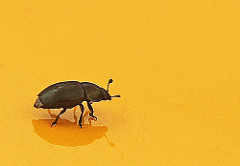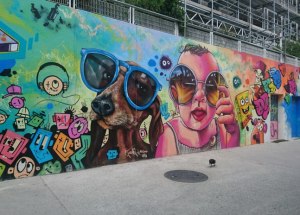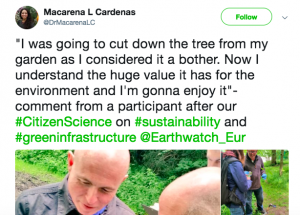On a sunny summer’s day about five years ago, I was doing the laundry – not particularly enjoying it. I hung the clothes on the line in my garden to dry. I was about halfway done when my daughter, four years old at the time, came up to me and asked: “What are all these little black bugs on that yellow shirt? And why are there so many on that single shirt and none on any of the other clothes?”
At that point I could have made an educated guess or even give her a made up answer, but I did something else instead. I asked a question back. “Why do you think this could be the case?” She first thought they may just like that particular shirt, but then wondered whether yellow was their favourite colour. Again, I decided to answer with a question – being more than happy to procrastinate some more from my household tasks: “How do you think we could find out whether you are right?”
Now she got really excited and we ended up rummaging through the whole house, trashing the kid’s wardrobe and then moving on to mine followed by the tea towels and dress-up box, dragging out more and more clothes in all shapes and colours and putting them on the line. We lined up all the shades of yellow, red, green and blue we could find and endlessly counted pollen beetles, until my husband got home, raising an eye-brow at the chaos in our house, the line full of random clothes and the basked that was still half full of wet laundry. But when our daughter explained with great excitement how she had done a real experiment to find out about pollen beetles, he couldn’t help but smile too.

Pollen beetle enjoying its yellow perch. Picture: flikr user nutmeg66
Team work
I recently recounted this story, which made me wonder, why are the vast majority of people not involved in scientific research, while it only takes two simple questions to get a 4-year-old to design and execute a real experiment? Part of the answer undoubtedly lies in our education system with its emphasis on learning facts rather than fostering curiosity. But I will leave that for another blog to explore.
A more important issue is that science currently isn’t very open or accessible for lay people and that needs to change. Our pollen beetle experiment was a real experiment in the sense that we started with a ‘research question’ (why are there so many beetles on one shirt and hardly any on the other clothes?), created a ‘hypothesis’ (they are attracted by yellow) and then came up with an ‘experimental design’ (multiple shirts in different shades of yellow, red, green and blue) to test our assumptions. But what we didn’t do is check whether this knowledge was already available in the scientific literature and needless to say, we also failed to publish our own results in a peer-reviewed journal.
These additional steps are more challenging to conduct for someone who is not a trained scientist. There is such a vast amount of information out there that finding and synthesising this knowledge is a skill in its own right, a skill that prospective scientists learn at university. Moreover, a lot of scientific knowledge is stored behind expensive pay-walls, only accessible to those with access to a university library.
It’s also not easy to design an experimental set-up that is really robust and controls for all sorts of environmental variables that may impact the results (e.g. if I would happen to have only yellow shirts made of cotton, but blue shirts made of synthetic fibres then I can’t conclude that the beetles prefer yellow, they may just prefer cotton). Again, scientific training helps avoid the most common pitfalls. The peer-review system – other scientists who haven’t been involved but who check whether the experiment was well designed and whether the conclusions are justified – is equally hard to navigate as a non-professional. In spite of all its flaws, peer review is still one of the best system we have to safeguard against misleading conclusions and therefore forms an important part of the scientific process.
Collaboration with scientists thus greatly enhances opportunities for members of the public to use their curiosity to make valuable contributions to our collective knowledge base and to learn about their local environment. One organisation that facilitates this is Earthwatch.
However, it is less appreciated that scientists also benefit from such collaboration. They get help with data collection and data analyses. They get insight into what questions people really care about and thus crucial understanding of the knowledge people actually want to use to improve their local environment. And most importantly, by involving a lot more people they get access to a lot more brains. Brains with different experiences, viewpoints, values and ideas. It is this diversity that inevitably will lead to innovative solutions. Given the enormous challenges our planet is facing – from climate change to deforestation and from plastic pollution to the decline of pollinators – this is an opportunity we can’t turn down!
And in case you are wondering whether faffing about with laundry in your garden is worthy of the title science, you may be surprised to learn how many of the biggest scientific discoveries started in this way. For example, the discovery of graphene, the world’s thinnest and strongest material, which received the Nobel prize for physics in 2010, started with a Friday afternoon of faffing around with pencils and sticky tape. And what about a global network of esteemed soil scientists who use tea bags (Rooibos and Green tea to be precise) to measure the impact of climate change?
Barriers
Collaboration between members of the public and scientists increasingly happens in ‘citizen science’ projects. This is a great development, but the fact is that a lot of people – both members of the public and professional scientists – are not yet on board. There is also more work to be done to stimulate collaboration as equal partners and allow participants to contribute data as well as new ideas on data collection and analysis, making them full partners in the entire scientific process.
To open up science for all and stimulate collaboration on a level playing field we need to co-create knowledge. We need to blur the lines between ‘scientists’ and ‘participants’ and acknowledge that everyone brings valuable knowledge to the table. We need to tackle barriers caused by jargon, facilitate mutual understanding and respect and we need to listen to each other and create neutral meeting spaces.

Ideas on how to share knowledge and increase diversity of citizen science from the workshop ‘sharing the love of citizen science’ at the 2018 ECSA conference in Geneva.
One step at a time
For someone who has never participated in a science project, it can be a daunting thought to help design and conduct top-level research as an equal partner. Equally, for researchers who are used to operating in the ivory tower of their institution, the thought of having to collaborate with members of the public who do not share the same training and values can seem impossible.
As with anything in life, we learn most when we are pushed just outside our comfort zone, but if we are pushed too far out, we get stressed, communication breaks down and things don’t end well. We shouldn’t expect the transition to widespread public involvement in scientific research to happen overnight, but we should push the boundaries and gradually nudge scientists and lay public closer together.
In order to do this, we need to view the world through their eyes and truly understand where people are coming from. What are their values, what do they know, what is absolutely alien to them? This will also require new funding models for science, which allow for innovative ways to create and deliver new research projects, fostering collaboration and offering coaching (on both sides) to support knowledge co-creation.

Watching the world through different eyes. Picture: Gitte Kragh.
The power of being part of the solution
The reward for doing this is immense. Giving people an opportunity to influence and shape their own future, to be part of the solution rather than the culprit who brings further destruction to the planet with each item you buy or each car journey you make, is incredibly empowering. The internet is rife with examples of such empowered individuals, from small lightbulb moments to life-changing discoveries.

A bright future?
So, can curiosity – asking questions and doing your own science to answer them – save our planet? Time will tell. But surely, the odds of finding solutions to the challenges we are facing are much better when everyone feels part of the solution and when we use all the brain power in the world. And according to my daughter, it’s a lot more fun this way too.
Toos van Noordwijk
Director of Engagement and Science at Earthwatch Europe (Earthwatch.org.uk)

